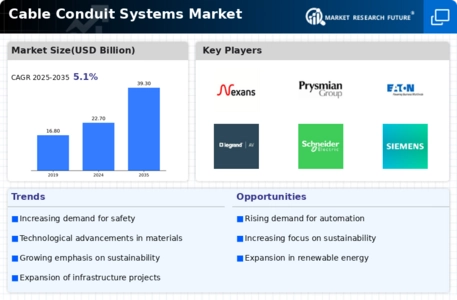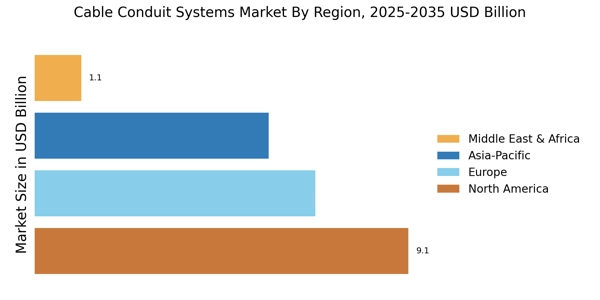Regulatory Compliance
Stringent regulatory frameworks regarding electrical safety and environmental standards are driving the Cable Conduit Systems Market. Governments worldwide are implementing regulations that mandate the use of specific materials and installation practices to ensure safety and sustainability. Compliance with these regulations often requires the use of high-quality cable conduits that meet established standards. For instance, the National Electrical Code in various regions outlines specific requirements for conduit systems, influencing purchasing decisions in the market. As industries strive to adhere to these regulations, the demand for compliant cable conduit systems is likely to increase, thereby propelling market growth. This trend underscores the importance of regulatory compliance in shaping market dynamics.
Increased Energy Demand
The rising The Cable Conduit Systems Industry. As populations grow and economies develop, the need for reliable energy infrastructure becomes critical. The International Energy Agency has projected that global energy demand will increase by 30% by 2040, necessitating the installation of extensive electrical systems. This surge in energy requirements drives the need for effective cable management solutions, including conduits that can withstand various environmental conditions. Furthermore, the transition towards renewable energy sources, such as solar and wind, also requires specialized conduit systems to protect cables in diverse settings. Thus, the energy sector's expansion is likely to bolster the demand for cable conduits.
Infrastructure Development
The ongoing expansion of infrastructure projects across various sectors is a primary driver for the Cable Conduit Systems Market. Governments and private entities are investing heavily in the construction of roads, bridges, and buildings, necessitating robust cable management solutions. For instance, the construction sector is projected to grow at a compound annual growth rate of approximately 4.5% over the next few years, which directly correlates with increased demand for cable conduits. These systems are essential for protecting electrical wiring and ensuring safety in new constructions. As urbanization continues to rise, the need for efficient and durable cable conduit systems becomes even more pronounced, indicating a sustained growth trajectory for the market.
Technological Advancements
Technological advancements in materials and manufacturing processes are reshaping the Cable Conduit Systems Market. Innovations such as the development of lightweight, high-strength materials and improved production techniques are enhancing the performance and durability of cable conduits. For example, the introduction of flexible conduits made from advanced polymers allows for easier installation and better adaptability in complex environments. Additionally, the integration of smart technologies into cable management systems is becoming more prevalent, enabling real-time monitoring and maintenance. These advancements not only improve the efficiency of electrical installations but also reduce long-term costs, making them attractive to consumers. As technology continues to evolve, the market for cable conduits is expected to expand further.
Growing Telecommunications Sector
The rapid expansion of the telecommunications sector is a significant driver for the Cable Conduit Systems Market. With the increasing demand for high-speed internet and mobile connectivity, telecommunications companies are investing heavily in infrastructure development. The Cable Conduit Systems Market is expected to grow at a CAGR of around 5% over the next few years, leading to a heightened need for effective cable management solutions. Cable conduits play a crucial role in protecting and organizing the extensive cabling required for telecommunications networks. As 5G technology continues to roll out, the demand for robust and reliable conduit systems is likely to surge, further enhancing the market's growth prospects.


















Leave a Comment